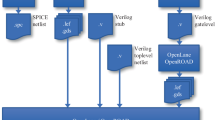Abstract
This paper presents a functional compiler for the automatic design of Direct Digital Frequency Synthesizer (DDFS) integrated circuits (ICs) using a ROM based table look-up architecture. The compiler allows the user to specify high-level specifications such as the acceptable spurious response and it generates the IC architecture, floorplan, and layout. To construct the layout for different specifications, a library of parameterized macrocells has been developed in 1.2 μm CMOS technology.
A test chip with a quadrature DDFS module has been generated, using the compiler, and fabricated. The chip has two input signals: one is for frequency control while the other is for phase initialization. Input and output word lengths are 16 bits and 6 bits respectively. The chip complexity is approximately 12,000 transistors (DDFS core) and the die size is 4.8×2.9mm 2. A maximum sample rate of 80 MHz has been attained implying a maximum sine (cosine) output frequency of 40 MHz and a frequency resolution of 1.22 kHz. The maximum spurious level measured is −46 dB.
Similar content being viewed by others
References
P.B. Tjahjadi, P.T. Yang, B.C. Wong, B.Y. Chung, E.G. Cohen, and R. Jain, ”VANDA—a CAD system for communication signal processing circuits design,” inVLSI Signal Processing IV, IEEE Press, New York, 1990.
R. Jain, H. Samueli, P. Yang, C. Chien, G. Chen, L. Lau, B.Y. Chung, and E. Cohen, “Computer aided design of a BPSK spreadspectrum chip set,” to appear inIEEE J. Solid-State Circuits, vol. 27, January 1992, pp. 44–58.
J. Tierney, C. Rader, and B. Gold, “A digital frequency synthesizer,”IEEE Trans. on Audio and Electroacoustics, vol. AU-19, 1971, pp. 48–57.
H.T. Nicholas, H. Samueli, and B. Kim, “The optimization of direct digital frequency synthesizer performance in the presence of finite wordlength effects,” inProc. of the 42nd Annual Frequency Control Symposium, 1988, pp. 357–363.
C. Shung, R. Jain, K. Rimecy, E. Wang, M. Srivastava, E. Lettang, S. Azim, B. Richards, P. Hilfinger, J. Rabaey, and R. Brodersen, “An integrated CAD system for algorithm-specific IC design,”IEEE Trans, on CAD, 1991, pp. 447–463.
D. Sunderland, R. Strauch, S. Wharfield, H. Peterson, and C. Cole, “CMOS/SOS frequency synthesizer LSI circuit for spread-spectrum communications,”IEEE J. Solid-State Circuits, vol, SC-19, 1984, pp. 479–505.
H.T. Nicholas and H. Samueli, “A 150-MHz direct digital frequency synthesizer in 1.25μm CMOS with −90dBc spurious performance,rd to appear inIEEE J. Solid-State Circuits, vol. 26, December 1991, pp. 1959–1969.
D.A. Hodges and H.G. Jackson,Analysis and Design of Digital Integrated Circuits, New York: McGraw-Hill, 1988, pp. 354–357.
Stanford Telecommunication, Inc.,The DDS Handbook, second ed., ASIC Custom Products Group, 2421 Mission College Blvd., Santa Clara, CA 95054, 1990.
Author information
Authors and Affiliations
Rights and permissions
About this article
Cite this article
Lau, L.KL., Jain, R., Samueli, H. et al. DDFSGEN. J VLSI Sign Process Syst Sign Image Video Technol 4, 213–226 (1992). https://doi.org/10.1007/BF00925123
Received:
Revised:
Published:
Issue Date:
DOI: https://doi.org/10.1007/BF00925123




